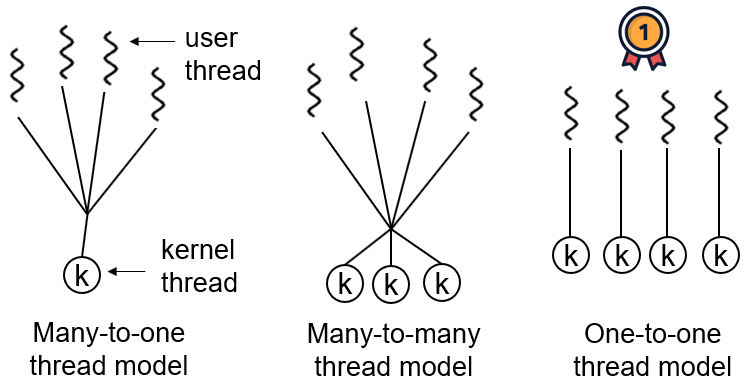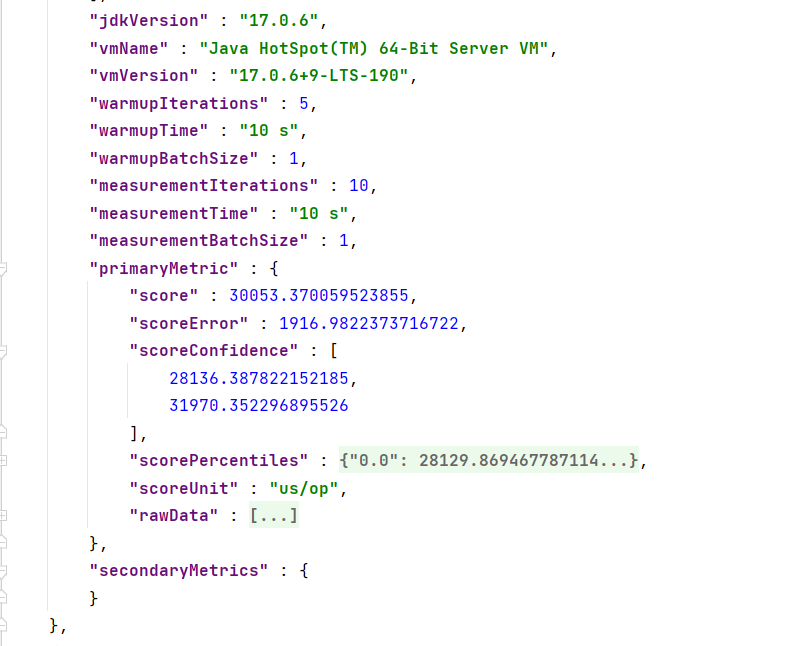剑指offer 59~69
59~69 on building…
59 - I. 滑动窗口的最大值
难度困难474
给定一个数组 nums 和滑动窗口的大小 k,请找出所有滑动窗口里的最大值。
- 暴力解法
1 | class Solution { |
- 单调队列
59 - II. 队列的最大值
难度中等403
请定义一个队列并实现函数 max_value 得到队列里的最大值,要求函数max_value、push_back 和 pop_front 的均摊时间复杂度都是O(1)。
若队列为空,pop_front 和 max_value 需要返回 -1
对于入队操作以及出队操作, 直接使用
Queue的API即可对于
MAX_VALUE,如果要实现O(1)的复杂度, 需要使用Deque
- 使用辅助队列
Deque, 用来储存最大值
1 | class MaxQueue { |
60. n个骰子的点数
难度中等464
把n个骰子扔在地上,所有骰子朝上一面的点数之和为s。输入n,打印出s的所有可能的值出现的概率。
你需要用一个浮点数数组返回答案,其中第 i 个元素代表这 n 个骰子所能掷出的点数集合中第 i 小的那个的概率。
- 动态规划
- 在前面计算的dp数组的概率的基础上, 都添加6 个分支
temp[j+k]+=dp[j]/6.0;,
通过子问题的解 f(n - 1) 可递推计算出 f(n) ,而输入一个骰子的解 f(1) 已知,因此可通过解 f(1)依次递推出任意解 f(n) 。
假设有两个骰子A、B,这两个骰子相互独立。
在仅有一个骰子A的情况下,6个点出现的概率都为1/6, 同时A的每个点搭配B的每个点的概率也是相同的,所以骰子A为1会分别乘6个1/6去搭配骰子B的1~6, 即这种搭配2~7的概率分别都为1/36; 骰子A的2也会分别去乘6个1/6去搭配骰子B的1~6, 即这种搭配3~8的概率也分别为1/36, 以此类推。
因为这是独立重复试验,所以之间的关系是相加,所有实验相加后,就得到了最终的结果。
1 | class Solution { |
61. 扑克牌中的顺子
难度简单261
从若干副扑克牌中随机抽 5 张牌,判断是不是一个顺子,即这5张牌是不是连续的。2~10为数字本身,A为1,J为11,Q为12,K为13,而大、小王为 0 ,可以看成任意数字。A 不能视为 14。
1 | class Solution { |
- 最后几行的返回可以 简写,
1 | class Solution { |
62. 圆圈中最后剩下的数字
难度简单656
0,1,···,n-1这n个数字排成一个圆圈,从数字0开始,每次从这个圆圈里删除第m个数字(删除后从下一个数字开始计数)。求出这个圆圈里剩下的最后一个数字。
例如,0、1、2、3、4这5个数字组成一个圆圈,从数字0开始每次删除第3个数字,则删除的前4个数字依次是2、0、4、1,因此最后剩下的数字是3。
- 约瑟夫环问题
暴力模拟时间复杂度*O(MN)*显然是不可取的
image-20220809160509100
正确的做法是使用动态规划:
我们首先将这个问题 当做一个 「n, m 问题」
-
由于删除的是第m个数字, 因此实际删除的数字是
(m-1), 又因为 m可能大于n, 所以实际删除的数字是(m-1)%n -
删除后的数字环从下一个数字开始 (将这个数字视为第一个数字, ) ,即
m%n, 设t= m%n -
那么可以得到新的数字环是:
t, t+1, t+2 , t+3 .......0 , 1 , t-3 ,t-2, (t-1刚刚被删除了)「n -1 , m 问题」 的数字环是:
0 , 1 , 2 , 3 , ...... t, t+1 ... n-2 -
删除一轮后的数字环变为了一个「n -1 , m 问题」, 下面是数字的编号以及对应的关系:
「n -1 , m 问题」 「n , m 问题」 0 t+0 1 t+1 2 t+2 … … n-2 t-2 -
我们假设 **「n -1 , m 问题」**中的某一个数字为
x,-
那么可以得到递推关系:
x----> (x+t)%n
-
那么如果这个x 恰好是**「n -1 , m 问题」** 的解(记为f(n) , 由此我们可以得到:
f(n) = (f(n-1) + t) % n
= (f(n-1) + m%n ) % n
= (f(n-1) + m ) % n
因此, 我们可以通过f (1)来递推之任意的f(n),
- 而「1,m 问题」的解
f(1) = 0恒成立,即无论 m 为何值,长度为 1 的数字环留下的是一定是数字 0 。
动态规划:
状态定义: 设**「i,m 问题」**的解为
dp[i];
转移方程: 通过以下公式可从 dp[i - 1]递推得到dp[i];
dp[i]=(dp[i−1]+m)%i初始状态:「1, m1,m 问题」的解恒为 00 ,即
dp[1] = 0;
返回值: 返回「n, m问题」的解 dp[n] ;
时间复杂度: O(n)
空间复杂度: O(1)
根据状态转移方程的递推特性,无需建立状态列表 dp ,而使用一个变量 x 执行状态转移即可。
1 | class Solution { |
63. 股票的最大利润
难度中等278
假设把某股票的价格按照时间先后顺序存储在数组中,请问买卖该股票一次可能获得的最大利润是多少?

暴力解法时间复杂度 达到O(n2) ,舍弃
正确的做法是使用动态规划, 随着天数的增加获得最低价格以及最高的售价 , 然后每次统计利润是否增加
1 | class Solution { |
64. 求1+2+…+n
难度中等523
求 1+2+...+n ,要求不能使用乘除法、for、while、if、else、switch、case等关键字及条件判断语句(A?B:C)。
- cpp 利用构造函数求解
1 | class Solution { |
- java利用
&&求解 , (递归)
1 | class Solution { |
65. 不用加减乘除做加法
难度简单338
写一个函数,求两个整数之和,要求在函数体内不得使用 “+”、“-”、“*”、“/” 四则运算符号。
- 利用
^以及&, 巧妙的进行相加
首先 ,我们有两个数字,
- 需要先获取 非进位的和 n (n= a^b)
- 然后获取进位的和 : p (p=a&b<<1)
- 然后我们 通过
n= n^p就得到了和 ( 进位和 + 非进位和)
9 : 1001
26: 11010
n: 10011
p: 10000
n: 00011, 可见, 如果仅仅是n^p可能存在新的进位的情况 ,
此时我们继续使用 p 来记录 n&p<<1 的结果 ,
p: 100000
这里需要用到一个新的数字(temp)来储存n&p<<1的结果, 因为如果先 异或再 & , 就会导致先相加, 再&, 相当于重复计算了
然后继续执行上一步类似的操作 也就是 n= n^p
n:100011 : 35得到正确结果
1 | class Solution { |
66. 构建乘积数组
难度中等257
给定一个数组 A[0,1,…,n-1],请构建一个数组 B[0,1,…,n-1],其中 B[i] 的值是数组 A 中除了下标 i 以外的元素的积, 即 B[i]=A[0]×A[1]×…×A[i-1]×A[i+1]×…×A[n-1]。不能使用除法。
- 使用
BigInteger.divide()方法,显然不行, 题目说了不可以使除法
1 | import java.math.BigInteger; |
- 左右累乘, 通过
b[]来记录左边的累乘的结果, 通过temp 来记录右边的累乘的结果, - 注意
temp计算的时候是从右下角开始累乘 
1 | class Solution { |
67. 把字符串转换成整数
难度中等179
写一个函数 StrToInt,实现把字符串转换成整数这个功能。不能使用 atoi 或者其他类似的库函数。
首先,该函数会根据需要丢弃无用的开头空格字符,直到寻找到第一个非空格的字符为止。
当我们寻找到的第一个非空字符为正或者负号时,则将该符号与之后面尽可能多的连续数字组合起来,作为该整数的正负号;假如第一个非空字符是数字,则直接将其与之后连续的数字字符组合起来,形成整数。
该字符串除了有效的整数部分之后也可能会存在多余的字符,这些字符可以被忽略,它们对于函数不应该造成影响。
注意:假如该字符串中的第一个非空格字符不是一个有效整数字符、字符串为空或字符串仅包含空白字符时,则你的函数不需要进行转换。
在任何情况下,若函数不能进行有效的转换时,请返回 0
 image-20220811100252623
image-20220811100252623
1 | class Solution { |
68 - I. 二叉搜索树的最近公共祖先
难度简单252
给定一个二叉搜索树, 找到该树中两个指定节点的最近公共祖先。
百度百科中最近公共祖先的定义为:“对于有根树 T 的两个结点 p、q,最近公共祖先表示为一个结点 x,满足 x 是 p、q 的祖先且 x 的深度尽可能大(一个节点也可以是它自己的祖先)。”

对于两个节点, 他们的对于祖先的分布有三种情况:
- 两个子节点都在左子树
- 两个子节点都在右子树
- 两个子节点一左一右分布在子树
- 这种情况, 对应的最近公共祖先就是当前的节点( 在深入的话就没有公共祖先了)
由于题目给的是二叉搜索树 , 那么可以直接利用 特性比较即可
1 | /** |
68 - II. 二叉树的最近公共祖先
难度简单470
给定一个二叉树, 找到该树中两个指定节点的最近公共祖先。
百度百科中最近公共祖先的定义为:“对于有根树 T 的两个结点 p、q,最近公共祖先表示为一个结点 x,满足 x 是 p、q 的祖先且 x 的深度尽可能大(一个节点也可以是它自己的祖先)。”
其实思路跟上一题一样, 区别在于判断节点位于根节点的左右子树的方法不同
- 通过递归判断节点是否是当前的节点的子节点
- 时间复杂度很高
1 | /** |
通过递归对二叉树进行先序遍历, 当遇到节点 p或 q 时返回。从底至顶回溯,当节点 p,q 在节点 root的异侧时,节点 root即为最近公共祖先,则向上返回 root。

分别递归左右子树, 如果遇到了
pq节点就返回,对于
left以及right共有三种情况
- 都不为null , 说明当前的root 就是最近的公共祖先(
return root)- 如果都为null , 说明左右子树中都没有p ,q , 返回
null(return right)- left和right中只有一个不为null, 说明两个节点在左右子树的同一侧
- left为null : 说明p q 都在根节点的右子树中, 直接返回 right
- p, q其中一个在root 的右子树中 , 此时
right指向p , q其中一个- p, q都在root 的右子树中, 此时
right指向两个节点的最近公共祖先- 如下图中的
0 8, 由于left!=null&&right!=null==>return root:1- right为null:
- 同理, 不再赘述

1 | class Solution { |











